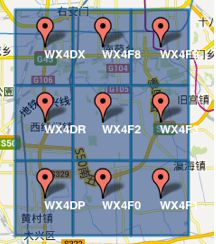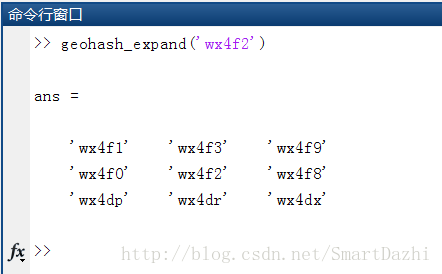GeoHash在matlab中工具包编写
1.基础知识
以下是我之前看到不错的博文
1.GeoHash核心原理解析 http://www.cnblogs.com/LBSer/p/3310455.html
2.GeoHash距离大致估计 http://blog.csdn.net/bitcarmanlee/article/details/55824141
3.C实现GeoHash编码 http://blog.csdn.net/chen77716/article/details/5576668
4.基于GEOHASH算法的附近点搜索实现 http://www.cnblogs.com/subaiBlog/p/5410590.html
2.Matlab代码
1.对经纬度进行编码
function geohash=encode(lat,lot,prec) %编码
% Base32编码
Base32= '0123456789bcdefghjkmnpqrstuvwxyz';
latitude=[-90,90];%纬度
longitude=[-180,180];%经度
length=prec*5;%需要的二进制编码长度
k=1;
bits=zeros(1,5);%记录二进制码
l=1;
for i=1:length
if mod(i,2)~=0
mid=mean(longitude);
if lot>mid
bits(l)=1;
l=l+1;
longitude(1)=mid;
else
bits(l)=0;
l=l+1;
longitude(2)=mid;
end
else
mid=mean(latitude); %从1开始奇数位为纬度
if lat>mid
bits(l)=1;
l=l+1;
latitude(1)=mid;
else
bits(l)=0;
l=l+1;
latitude(2)=mid;
end
end
if ~mod(i,5)
geohash(k)=Base32(1*bits(5)+2*bits(4)+4*bits(3)+8*bits(2)+16*bits(1)+1);
bits=zeros(1,5);
l=1;
k=k+1;
end
end2.将geohash编码解码成经纬度
function [lat,lot]=docode(geoh) %解码
% 编码长度
Len=size(geoh,2);
% Base32编码
Base32= '0123456789bcdefghjkmnpqrstuvwxyz';
% geoh为待解析的编码,是字符串
%当前计算位的奇偶性
odd = true ;
latitude=[-90,90];%纬度
longitude=[-180, 180];%经度
for i=1:Len
for j=1:32
if(Base32(j)==geoh(i))
bits=j-1; % 找到第i个字符对应的数
break;
end
end
for jj=1:5
j=6-jj;
switch j
case 5
ad=16;
case 4
ad=8;
case 3
ad=4;
case 2
ad=2;
case 1
ad=1;
end
if bitand(bits,ad)
bit=1;
else
bit=0;
end % 取出对应的位
if odd
mid = (longitude(1) + longitude(2)) / 2;
if bit==0
longitude(2)= mid;
else
longitude(1)= mid;
end
else
mid = (latitude(1) + latitude(2)) / 2;
if bit==0
latitude(2)= mid;
else
latitude(1)= mid;
end
end
odd = ~odd;
end
end
lat = (latitude(1) + latitude(2)) / 2;
lot = (longitude(1) + longitude(2)) / 2;
end3.根据当前区域的GeoHash,推算出周围8个方位区域块的的GeoHash值。使用递归实现,输出为九个宫格形式。
function expand=geohash_expand(geoh)
% 编码长度
Len=size(geoh,2);
% Base32编码
Base32= '0123456789bcdefghjkmnpqrstuvwxyz';
% geoh为待解析的编码,是字符串
n=0;
str1='';
str='';
expand=cell(3);
for i=1:Len
n=find(Base32==geoh(i));
n=n-1;
str1=dec2bin(n,5);
str=[str,str1];
end
code=str;
len=size(code,2);
code=findup(code,len); %九宫格,第一个geohash
code=findleft(code,len);
expand(1,1)={bin2geohash(code,len)};
code=str;
code=findup(code,len);
expand(1,2)={bin2geohash(code,len)}; %九宫格,第二个geohash
code=str;
code=findup(code,len);
code=findright(code,len);
expand(1,3)={bin2geohash(code,len)};%九宫格,第三个geohash
code=str;
code=findleft(code,len);
expand(2,1)={bin2geohash(code,len)};%九宫格,第四个geohash
expand(2,2)={geoh}; %九宫格,第五个geohash,也是正中心位置
code=str;
code=findright(code,len);
expand(2,3)={bin2geohash(code,len)};%九宫格,第六个geohash
code=str;
code=finddown(code,len);
code=findleft(code,len);
expand(3,1)={bin2geohash(code,len)};%九宫格,第七个geohash
code=str;
code=finddown(code,len);
expand(3,2)={bin2geohash(code,len)};%九宫格,第八个geohash
code=str;
code=finddown(code,len);
code=findright(code,len);
expand(3,3)={bin2geohash(code,len)};%九宫格,第九个geohash
%%用于将二进制字符串转换成geohash
function geohash=bin2geohash(str,len)
Base32= '0123456789bcdefghjkmnpqrstuvwxyz';
geohash='';
str1='';
len=(len/5);
for i=1:len
str1=Base32(bin2dec(str((i-1)*5+1:i*5))+1);
geohash=[geohash,str1];
end
function code=findup(code,len)
if len<=1
return;
end
len=len-2;
if code(len+2) == '1'
code=findup(code,len);
code(len+2)='0';
else
code(len+2)='1';
end
function code=finddown(code,len)
if len<=1
return;
end
if code(len)=='0'
len=len-2;
code=finddown(code,len);
code(len+2)='1';
else
code(len)='0';
end
function code=findleft(code,len)
if len<=1
return;
end
len=len-1;
if code(len) == '0'
len=len-1;
code=findleft(code,len); %不要写成code=findright(code,len-1),浪费了一下午找原因
code(len+1) = '1';
else
code(len) = '0';
end
function code=findright(code,len)
if len<=1
return;
end
len=len-1;
if code(len) == '1'
len=len-1;
code=findright(code,len);
code(len+1) = '0';
else
code(len) = '1';
end
这里得到九宫格是和上图中成镜像关系,也就是一个是顺时针,一个为逆时针,其余均相同。
以上代码均放在GitHub托管,欢迎下载https://github.com/Wangxingzhi/geohash

